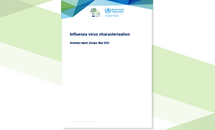Influenza virus characterisation - Summary Europe, April 2021
ECDC’s influenza virus characterisation reports are published periodically and give an overview of circulating influenza viruses. They provide details on the current vaccine strains, summarise the development of the viruses since the last report, and closely follow the main developments for the ongoing influenza season. Virus characterisation reports are primarily intended for influenza virologists and epidemiologists.
Executive Summary
This is the sixth report for the 2020-2021 influenza season. As of week 17/2021, only 865 influenza detections across the World Health Organization (WHO) European Region had been reported to The European Surveillance System (TESSy); 50% type A viruses, with A(H3N2) and A(H1N1)pdm09 being approximately equally represented, and 50% type B viruses, with only 16 having been ascribed to a lineage, 13 B/Victoria and three B/Yamagata. This represents a 99.5% drop in detections compared to the same period in 2020, probably due to the COVID-19 pandemic and measures introduced to combat it.
Since the March 2021 characterisation report, no shipments from European Union/European Economic Area (EU/EEA) countries have been received at the London WHO Collaborating Centre, the Francis Crick Worldwide Influenza Centre (WIC): consequently, little virus characterisation data has been generated. This report therefore focuses on genetic characterisation of the HA genes of seasonal influenza viruses with the most recent collection dates deposited and/or released in GISAID as of 30 April 2021, with collection date periods adjusted for each virus subtype/lineage to allow production of readable phylogenies. These data continue to show extremely low levels of influenza detections. Globally, few or no detections of A(H1N1)pdm09 and B/Yamagata-lineage viruses have been reported, while new variants of A(H3N2) and B/Victoria-lineage viruses have emerged, with the majority of detections reported by Asian and West African countries with evidence of wider geographic spread.
Of the 49 seasonal A(H1N1) pdm09 HA sequences reported to GISAID from viruses collected in the course of the 2020-2021 season, two are group 6B.1A5B, one group 6B.1A5A, 44 subgroup 6B.1A5A+187V/A represented by A/Guangdong-Maonan/SWL1536/2019 (the vaccine virus for the northern hemisphere 2020-2021 season), and two subgroup 6B.1A5A+156K represented by A/Victoria/2570/2019 (the vaccine virus for the southern hemisphere 2021 and northern hemisphere 2021-2022 influenza seasons). The great majority of 6B.1A5A group and subgroup viruses were detected in West African countries.
Download








